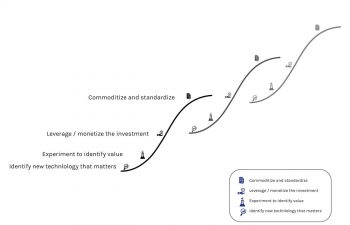Published on the 02/10/2017 | Written by Owen McCall

Thanks to Moore’s Law the S-Curves in technology are frighteningly short, writes Owen McCall…
Effective CIOs must identify, implement and then commoditise new technologies if they are to add value to their organisations. Just how they go about that process can be described by a mathematical model known as the S-Curve. More correctly the Sigmoid curve gets its name from its shape that approximates a stylised S. The model has been used by many people as a way of depicting the natural life cycle of just about everything. The curve has three general phases. A start up or initial phase, which is characterised by significant learning and adaption but little apparent growth, an explosive growth phase followed by a peak and decline. The essential point is everything has a natural lifecycle and nothing lasts forever. When it comes to innovation and business in general, the S Curve was perhaps most famously used by Charles Handy. Handy’s basic thesis is that the path to ongoing success is to begin to invest in the next curve before the last curve has peaked. You need to invest before the previous curve peaks so you have the resources you need to get through the initial learning phase. From an IT perspective the insight that the S Curve provides is that technology follows a reasonably predictable life cycle and for organisations to be sustainably successful in a digital era requires them to be very good at managing the technology S-Curves as they apply to their specific business. The problem is that thanks to Moore’s Law the S-Curves in technology are frighteningly short. A specific technology can go from differentiator to commodity in a few years and in this environment it is difficult to know when to invest. Let’s look at customer relationship management (CRM) systems as an example. Organisations have been investing in CRM systems of some form for many decades now. The CRM movement however, really took off in the 1990s with the emergence of sophisticated CRM systems from the likes of Siebel Systems. Large organisations around the world spent tens and sometimes hundreds of millions implementing these systems. Those who succeeded (and many didn’t) gained significant advantages over competitors as they gained increased customer visibility into and began to leverage information for mutual benefit to customers and the business. Then in 1999 Salesforce.com launched the first major SaaS solution for CRM and made this functionality available to everyone for a few dollars a month. First movers assumed the pathfinders risk, spent millions to differentiate themselves and were effectively neutralised within a decade (and that was in the comparatively slow moving 1990s). Rolling obsolescence They do this by being adept at identifying new and emerging technologies that matter, implementing and leveraging these technologies in a way that adds value and then commoditising them to industry standard as that technology and underlying capabilities mature and spread. Of course, all of this needs to be done in a way that ensures these new and commoditising capabilities are seamlessly integrated with previous investments and appropriately secure. No small task. This cycle is illustrated in the diagram below. Multiple moving parts Identifying emerging technologies that differentiate them in the market (ignoring those that don’t), implementing and leveraging these technologies in a way that drives value for their organisation and customers and then commoditise their once distinctive capabilities (perhaps with the help of an IT Operations counterpart), as there is little justification in continuing to maintain expensive bespoke capabilities that your competitors can replicate through standard systems and processes. And they need to do this all at the same time. In a digital world, competitive advantage is measured in a few years if you’re lucky and months if you’re not. That is, the time you have to turn an emerging technology enabled capability into cash, is short. You cannot afford to invest on the assumption that the advantage you gain will be sustainable for a significant period; besides, not all technologies will follow the full S-Curve. Many will never get out of phase 1. This means that while investment is necessary to remain relevant, any one investment is risky. This drives the experimentation approach to investment early in the S-Curve. The purpose of the experiments is to identify which innovations are likely to add significant value to your business and customers as early and as cheaply as possible. Those that work need to be implemented, leveraged and monetised as quickly as possible, because comoditisation is just around the corner. When comoditisation does catch you, you need to transition your specific processes to an appropriate ‘industry standard’ approach. There is no longer a premium for what you are doing so you need to eliminate the overhead of complex customised solutions; besides, you will not have the time to continue to maintain them as by now you will likely be well into leveraging your next cycle. The process never ends, new emerging opportunities will get quickly commoditised to be replaced by new emerging opportunities. Well, that’s not strictly true. Digital, like all innovations, will have its own lifecycle and eventually digital’s power over business will win. When will this happen? When Moore’s Law stops, or slows to a crawl, and all new technology advancements are evenly distributed across all businesses. When will this happen? Not soon, but really, your guess is as good as mine. Passionate about using technology to make a real difference to businesses, communities, families and individuals, Owen McCall has focused his career on understanding and answering this question: “How do you harness the power of IT to deliver value?”
One of the side effects of this constant differentiation and commoditisation is the rapid accumulation of technologically obsolete systems. Yesterday’s strategic platform is today’s expensive legacy system that is holding the organisation back. Even though we are still a comparably young industry established organisations may be running technology from 3 or 4 different eras. Needless to say, these technologies were not built to easily work with each other. Not a great set up for agility. To truly add value the CIO and his or her team, acting as the digital strategist for the organisation, needs to break this cycle or perhaps more appropriately learn to use this cycle for their own benefit.
Because of the speed with which technology S-Curves move, you will notice that there are several cycles in motion at any one time. The digital strategist needs to effectively work these cycles simultaneously.
An independent IT consultant, he is a former CIO of The Warehouse.







































